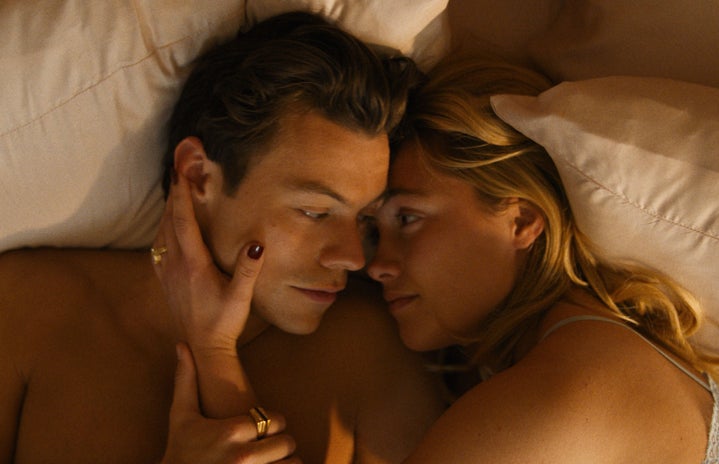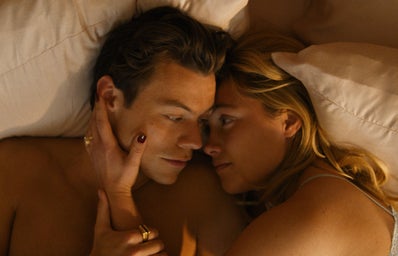Olivia Wilde’s highly anticipated psychological thriller, “Don’t Worry Darling,” opened on Sept. 23, and by now we’ve all had ample time to make our way to the theater to see it. Starring Florence Pugh and Harry Styles as lead couple Alice and Jack Chambers, this film is certified “rotten” on RottenTomatoes with a critic rating of 38% and an audience score of 74%. But was it really that bad? Proceed with caution and beware of spoilers because today we are breaking down and reviewing, “Don’t Worry Darling.”
The IMDB synopsis states that the film is a thriller and drama where “a 1950s housewife living with her husband in a utopian experimental community begins to worry that his glamorous company could be hiding disturbing secrets.”
Going into the movie, I didn’t expect to be blown out of the water. I usually love Florence Pugh and Chris Pine’s work, but I was wary of Harry Styles’ acting chops. With his limited acting experience prior to this role, casting Styles was a big risk for this production.
However, Styles’ acting wasn’t much of a detriment to the viewing experience. Pugh carried the film and his performance did a good job supporting hers while not stealing the spotlight. His portrayal of Jack was a healthy balance of patronizing and compassionate, but for most of the film, I wasn’t sure how far he’d go to sympathize with Alice. Of course, though, we did find out it was all an act.
Let’s talk about that plot twist, shall we? After going into the forbidden desert, the same way Alice’s neighbor, Margaret (KiKi Layne), did after losing her son, she traverses up to the “Victory Project” headquarters where she is plagued with strange imagery and weird occurrences in her everyday life. This comes to a head when she confronts Frank (Chris Pine) at a dinner party in front of all her closest friends. After this confrontation, Jack pretends to agree to run away with Alice, but when they get in the car, she is taken away for “treatment” –- a series of electroshock therapy sessions. It’s during this treatment that we finally see the façade start to break away.
The electroshock therapy allows Alice to see memories from her real life before she was living in Victory, Calif. Nothing she knew was real. In fact, she wasn’t living in the 1950s at all. Alice was a surgeon living in the present day.
I’m not going to call this twist predictable, because it wasn’t. But I did happen to whisper to my roommate, “What if it’s not even the ‘50s?”, minutes before it was revealed.
The most upsetting part of this twist is that Jack kidnapped Alice to force her to become part of the virtual reality called the “Victory Project.” He felt neglected because Alice worked such long hours at the hospital instead of being home, cooking meals for him and being subservient. In the present, she’s strapped to the bed with her eyes held open as she is forced to take in remnants of old pin-up girls and images from the 1950s that can immerse her in this fake world. Every day, when the men “go to work,” they’re actually leaving the “Victory Project” to work in the real world and, presumably, pay for the expensive costs of the VR.
When Alice returns home from her “treatment,” she tries to assimilate back in, but can’t escape memories of her real life. It all boils to the surface when she hears Jack singing a song from their previous life together. The memories all flood in and she confronts him. He finally confesses and pleads with her and, in a fit of desperation, Alice kills him. Soon after, her best friend, Bunny (Olivia Wilde), walks in and reveals to her that if Jack is killed in the VR, he dies in real life. Bunny then reveals that she’s the only woman who knows they’re in a simulation and that she actually sought out this life because she could not be with her children in the real world. Bunny tells Alice to run because Frank wants to kill her both in the “Victory Project” and in the real world.
What follows is a little bit confusing. Alice runs from what I can only describe as NPCs (nonplayer characters) and the women of the “Victory Project” seemingly begin to question their husbands. Next, we see Frank’s wife (Gemma Chan) kill him so that she can take the lead in the project. Alice makes it to headquarters, and we can assume that she escapes.
In my opinion, it’s an okay ending. Really. But it is a bit frustrating and doesn’t make up for any plot holes. If anything, it leaves more things to be questioned about this film. Like, why did Alice see a plane crash in the desert? Is there a more in-depth reason why Frank’s wife killed him? What caused all the glitches in the VR after Alice visited headquarters? Hasn’t the real world noticed that Alice is missing? More questions pile up the further I get from when I saw this film, and it’s frustrating to me that we have no answers.
At first watch, I gave this film two and a half stars on Letterboxd. I’m not sure I’d rank it so low on a second watch, as I think it could be interesting to watch this film another time knowing all the secrets and twists. However, the plot holes are glaring and it makes me wonder what could have been if this film had someone else at the helm and the original script was kept intact.
My final rating? Three out of five stars.


